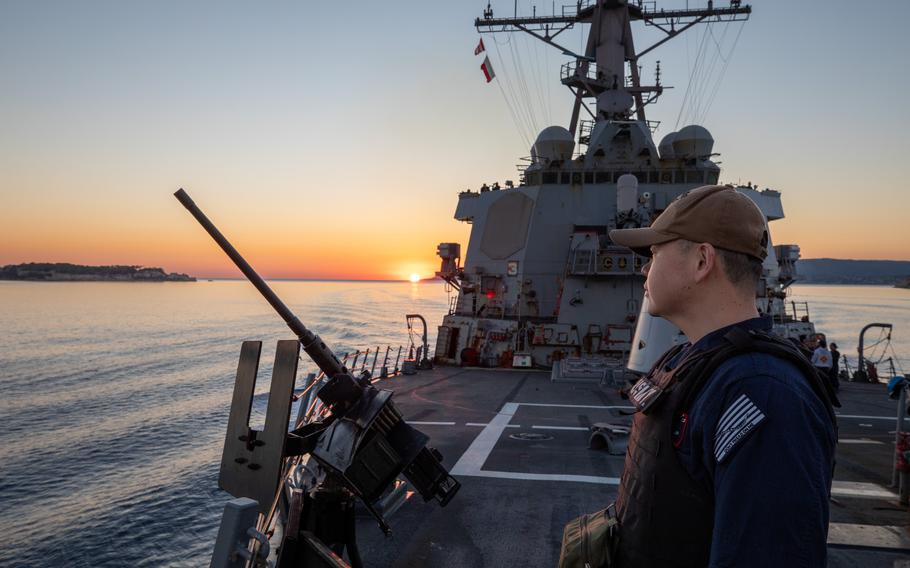
Culinary Specialist 2nd Class Heyang Sun stands watch aboard the Arleigh Burke-class, guided-missile destroyer USS Cole on Oct. 3, 2024. (Mark Peña/U.S. Navy)
WASHINGTON — The Navy is extending the service life of 12 aging destroyers as the service balances the need to keep ships at sea with the time it takes for new ships to join the fleet.
“Today’s budget-constrained environment requires the Navy to make prioritized investments to keep more ready players on the field,” said Adm. Lisa Franchetti, chief of naval operations. “The Navy is actively pulling the right levers to maintain and grow its battle force inventory to support the United States’ global interests in peace and to win decisively in conflict.”
The 12 destroyers that will remain in service, the Navy said, are Flight I destroyers, the oldest variant of the Arleigh Burke-class, guided-missile destroyers. The ships would have started to retire in 2028 but the Navy now plans to keep them in service until sometime between 2030 and 2036.
The Arleigh Burke-class destroyers typically have a service life of 35 years, but in recent years, the service has started extending the service of individual ships incrementally due to a rise in demand.
Multiple conflicts around the world are driving the need for more warships. The Navy has been forced to shuffle assets, pulling aircraft carriers supported by guided-missile destroyers from the Indo-Pacific region to deter conflict in the Middle East. At the same time, the Navy has had to rely more on destroyers, using the warships to fill in gaps left by retiring Ticonderoga-class, guided-missile cruisers. The service retired four cruisers in 2024, with nine remaining cruisers slated for decommissioning by 2027.
Additionally, the Navy has worked to reach a fleet of 355 ships to keep pace with a growing Chinese navy, which congressional lawmakers have said is expected to have a fleet of 400 in 2025. The U.S. Navy now boasts a fleet of about 300.
In 2014, the Navy began developing new destroyers to replace the older Arleigh Burke ships with the intention of the new class entering service in the 2030s. A Congressional Research Service report in August said the Navy is looking to purchase the first new class of destroyers in 2032 — four years after the Arleigh Burke-class would have previously had a ship retire.
The service-life extensions range from one to five years. The ships that will now remain active include:
• The USS Barry, which was set to retire in 2028 but will now remain in service until 2031.
• The USS John Paul Jones from 2028 to 2033.
• The USS Curtis Wilbur from 2029 to 2034.
• The USS Stout from 2029 to 2034.
• The USS John S. McCain from 2029 to 2034.
• The USS Laboon from 2030 to 2035.
• The USS Paul Hamilton from 2030 to 2035.
• The USS Stethem from 2030 to 2031.
• The USS Carney from 2031 to 2032.
• The USS Gonzalez from 2031 to 2036.
• The USS Cole from 2031 to 2036.
• The USS The Sullivans from 2032 to 2035.
The Navy said it evaluated each destroyer in the past 10 months and determined all 12 warships should remain operational beyond their expected service life. The Navy said it conducted hull-by-hull evaluations of the ship’s material condition, combat capability, technical feasibility and lifecycle maintenance requirements.
The decision follows a similar one announced last year to extend five Arleigh Burke destroyers. The USS Arleigh Burke — the oldest Flight I destroyer and the namesake of the class — is 33 years old, having joined the fleet in 1991. Its service life was extended in 2023 by five years through 2031. Also extended by five years in 2023 was the USS Ramage to 2035 and USS Benfold to 2036. The USS Mitscher and USS Milius were extended by four years to 2034 and 2035, respectively.
These destroyers are armed with vertical launch anti-submarine rockets, Tomahawk missiles and MK-46 torpedoes. They are designed for anti-air, anti-submarine and anti-surface warfare, and the most recent versions can simultaneously defend against aircraft and missiles, according to the Navy.
The service will propose funding in its fiscal 2026 budget request to maintain the destroyers beyond 35 years, the Navy said. The service did not indicate how much it might cost to keep the ships in the fleet.
“Extending these highly capable, well-maintained destroyers will further bolster our numbers as new construction warships join the fleet,” Navy Secretary Carlos Del Toro said. “It also speaks to their enduring role in projecting power globally, and most recently in the Red Sea, their proven ability to defend themselves, as well as our allies, partners and friends from missile and drone attacks.”
The ships have played a key role in mitigating conflict in the Middle East for more than a year. Destroyers have shot down drones launched by Iran-backed Houthi militants from Yemen that targeted merchant maritime shipping the Red Sea. The destroyers that have played a role in controlling conflict in the Middle East include the USS Arleigh Burke, USS Mitscher, USS Laboon, USS Russell, USS Ramage and USS Carney.
Two destroyers also helped defend Israel from a barrage of nearly 200 ballistic missiles launched by Iran. One of the ships, the USS Cole, is a Flight I Arleigh Burke-class destroyer.